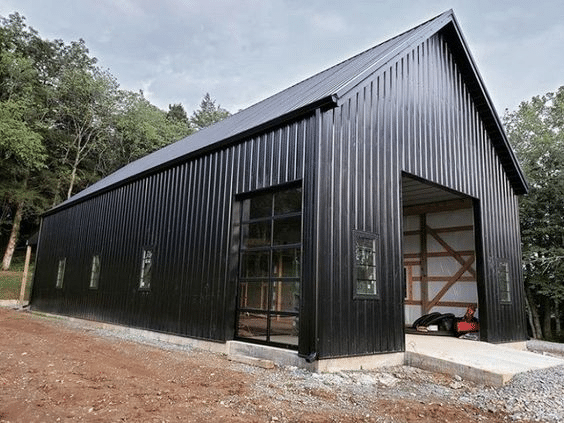Metal buildings are becoming a growing trend due to their inexpensiveness, speed of construction, and adaptability.
However, carefully choosing the right metal components is necessary to guarantee the structure’s quality and longevity.
This article will list the factors to consider when selecting steel materials for prefabricated steel buildings to help maximize efficiency and minimize costs.
7 Factors to Consider to Choose the Perfect Steel Building
Selecting a suitable metal building is a significant decision that involves evaluating various factors to ensure the structure aligns with your needs and expectations.
Here are seven crucial factors to guide you in making an informed choice:
1. Purpose and Functionality
Understanding the primary purpose of your steel building is not just essential; it’s empowering.
Will it be used for storage, a workshop, a garage, a barn, or a commercial enterprise?
Each use case has specific requirements to influence the building’s design, size, and features.
For instance, a workshop might need additional lighting and ventilation, while a storage shed may prioritize space efficiency.
Assessing the needed space involves more than measuring floor area.
Consider both horizontal and vertical dimensions. For instance, if you need to store large equipment or vehicles, the height of the building becomes crucial.
Ensure that the building can accommodate your needs regarding floor space and interior clearance.
2. Location and Site Preparation
The type of foundation required depends on the soil conditions and the building’s purpose.
Options include a concrete slab, which provides a solid base and helps with stability, or a gravel base, which can be more cost-effective but only suitable for some uses.
Proper site preparation is crucial for ensuring the building is level and stable.
Evaluating the local and environmental conditions is crucial.
These buildings must be designed to handle specific weather challenges such as heavy snow loads, high winds, or extreme temperatures.
Choosing the right design and materials resistant to local weather conditions can enhance the building’s durability and performance, giving you a sense of security and preparedness.
You can rest assured that your building can withstand weather conditions, providing peace of mind and confidence in your investment.
3. Building Codes and Regulations
Before proceeding, it’s essential to familiarize yourself with local building codes and zoning regulations.
These codes ensure the building meets safety and structural standards, including height restrictions, setback requirements, and load-bearing capacities.
Compliance with these codes is necessary to avoid legal complications and ensure the safety and longevity of your structure, making you feel informed and compliant.
It is critical to secure the necessary permits before construction starts.
Permits ensure that your building project complies with local regulations and building codes and help avoid potential fines or delays.
Failure to comply with these regulations can result in legal complications and even the demolition of your structure.
The permitting process may involve inspections and approvals, so factoring this into your planning timeline is essential.
4. Material Quality and Type
The type of metal used in the building’s construction affects its strength, durability, and maintenance needs.
Galvanized steel is known for its corrosion resistance and structural integrity, while aluminum offers lightweight properties and rust resistance.
Evaluate the benefits and limitations of each metal type based on your specific needs and budget.
These buildings can benefit from additional coatings and treatments that enhance their resistance to environmental factors.
For example, anti-corrosion coatings can protect against rust, while UV-resistant finishes can prevent fading and degradation from sunlight.
These treatments can extend the building’s lifespan and maintain its appearance over time.
5. Design and Customization
Design Options: Metal buildings come in various designs, from pre-engineered kits that offer convenience and cost savings to fully custom structures tailored to your specifications.
Consider the design elements most important for your use case, such as the number of doors, windows, or the overall aesthetic.
Explore customization options to tailor the building to your needs.
Features such as insulation, ventilation, and lighting can significantly impact the building’s functionality and comfort.
For instance, you can add insulation for temperature control, install skylights for natural light, or incorporate specialized doors for equipment access.
You can also customize the exterior with different colors or finishes to match your existing structures or enhance the building’s aesthetics.
Customization allows you to adapt the structure to your requirements, putting your needs at the forefront of the design process.
6. Budget and Cost
Establish a clear budget for your metal building project, including costs for materials, construction, and any additional features or customizations.
Getting detailed estimates and considering all potential expenses is essential to avoid budget overruns.
It’s not just about the initial investment. Evaluate ongoing costs such as maintenance, energy efficiency, and insurance.
Higher-quality materials and features have a higher initial cost but can lead to maintenance and energy bill savings over time.
For instance, energy-efficient designs and materials can reduce heating and cooling costs, while durable materials can lower repair and replacement expenses.
Being financially savvy now can lead to long-term savings.
7. Supplier and Manufacturer
Research potential suppliers and manufacturers to ensure they have a strong reputation for quality and reliability.
Look for customer reviews, request references, and verify their track record in the industry.
A reputable supplier is more likely to provide high-quality products and reliable service.
Review the manufacturer’s warranty and support options.
A comprehensive warranty protects against defects and issues that may arise after installation.
Good customer support is also crucial for addressing any concerns or problems that may occur during or after the construction process.
Conclusion
By thoroughly considering these factors and being prepared for potential challenges, you can make a well-informed decision and select a metal building that meets your needs, fits your budget, and offers long-term value and satisfaction.
Remember, challenges may arise, but with the proper knowledge and preparation, you can overcome them and complete your metal building project.








